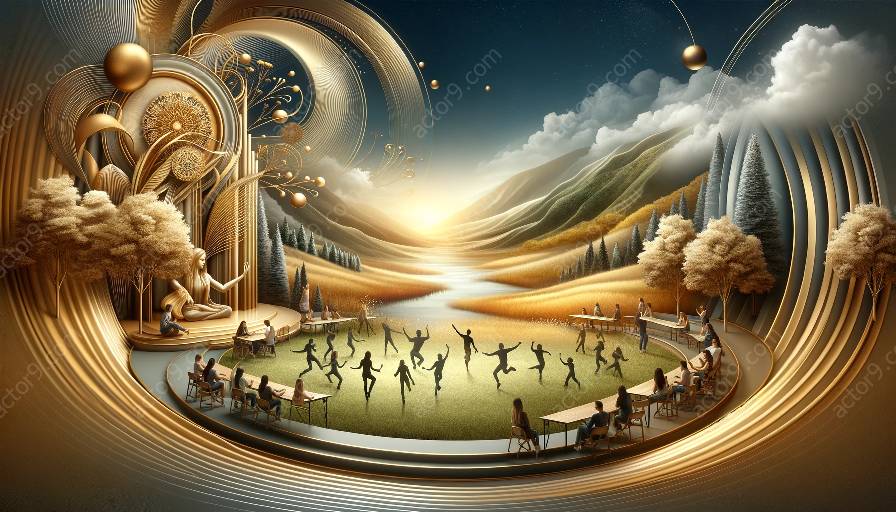Physical theatre, a dynamic form of performance art, has found its way into the realm of educational practices, offering unique and innovative opportunities for language and literature education. The integration of physical theatre techniques into language and literature instruction provides a holistic approach to learning, encompassing both the verbal and nonverbal dimensions of communication. By immersing students in the physicality of language and literary works, educators can enhance comprehension, critical thinking, and creative expression.
Physical theatre in education involves the utilization of movement, gesture, and spatial dynamics to convey narrative, emotion, and thematic concepts. This approach enables students to embody literary characters, explore dramatic interpretations of texts, and engage in kinesthetic learning experiences. The applications of physical theatre in language and literature education are wide-ranging and can be tailored to various educational settings, from elementary schools to higher education institutions.
The Role of Physical Theatre in Language and Literature Education
Physical theatre serves as a versatile tool for educators to immerse students in the world of language and literature. By incorporating physicality into the exploration of texts, educators can foster a multi-dimensional understanding of literary works, transcending traditional approaches that often focus solely on linguistic or textual analysis. Physical theatre techniques empower students to embody and enact the nuances of language, fostering a deeper connection with the emotional and sensory aspects of literary expression.
Furthermore, the integration of physical theatre in language and literature education promotes interactive and experiential learning. Through collaborative activities, improvisation, and ensemble-based exercises, students can explore and interpret literary themes, motifs, and characters in a dynamic and embodied manner. This approach not only enriches students' comprehension of the material but also cultivates teamwork, empathy, and creativity.
Enhancing Language and Literature Learning Through Physical Theatre
Physical theatre techniques offer a unique platform for enhancing language and literature learning by bridging the gap between textual interpretation and embodied expression. Through a focus on movement, spatial awareness, and physical expressivity, students can engage with language and literary works in a visceral and transformative manner. This approach encourages students to delve deeper into the emotional and symbolic layers of literature, enabling them to perceive the connections between physical gestures and linguistic meaning.
In language education, physical theatre can serve as a powerful tool for teaching vocabulary, grammar, and language usage. By incorporating physical movements and tableaux to represent word meanings and grammatical concepts, educators can create memorable and interactive experiences that aid in language acquisition. Additionally, physical theatre activities can be utilized to explore idiomatic expressions, figurative language, and cultural nuances embedded within literary texts, facilitating a more nuanced understanding of language and cultural contexts.
Moreover, physical theatre in literature education fosters a dynamic approach to character analysis and interpretation. By embodying literary characters through movement, gesture, and vocal expression, students gain a deeper insight into the motivations, emotions, and conflicts within the text. This embodied exploration encourages empathy and critical engagement with diverse perspectives, as students connect with characters on a physical and emotional level, transcending traditional methods of character analysis.
Integrating Physical Theatre into Language and Literature Curriculum
Integrating physical theatre into language and literature curriculum entails a conscious and deliberate approach to pedagogical design. Educators can weave physical theatre activities and exercises into lesson plans, unit structures, and assessment strategies to create a cohesive and immersive learning experience. By incorporating physical theatre as a complementary mode of exploration alongside traditional textual analysis, educators can cater to diverse learning styles and foster a more inclusive and engaging educational environment.
Furthermore, the integration of physical theatre into language and literature curriculum promotes interdisciplinary connections, fostering cross-disciplinary learning experiences that bridge the domains of performing arts, language studies, and literary analysis. Students can develop a deeper appreciation for the interplay between language, performance, and visual storytelling, expanding their creative and critical thinking skills through the integration of physical theatre techniques.
Conclusion
In conclusion, the applications of physical theatre in language and literature education offer a dynamic and innovative approach to engaging students with the power of language, expression, and storytelling. By embracing physical theatre techniques, educators can create immersive and transformative learning experiences that bridge the realms of the verbal and the physical, enriching language and literature education in profound ways. The integration of physical theatre not only enhances students' comprehension and interpretation of literary works but also nurtures their creative expression, empathy, and collaborative skills. Embracing physical theatre in language and literature education opens doors to an embodied understanding of language, literature, and the human experience.




































